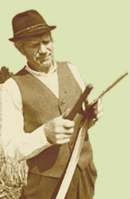Tree of the Year: Elm trees in Estonia
Elmar Kaar describes the trees of the year the Wych Elm and European White Elm and helps to differentiate between the two species. Both trees are native species of Estonia, but have become very rare in our natural forests and both are threatened by a fungus called Graphium ulmi, which has killed a large proportion of elm trees everywhere in Europe. Also, the main sorts of the Wych Elm are examined.
Assortment of packaging waste saves environment as well as ones wallet
Airi Andresson gives an overview of the audit made by the State Audit Office and draws attention to insufficiencies that hinder the re-use of packaging wastes to a large extent. It is clear that the state has to apply much stronger control mechanisms over packaging waste enterprises. The latter have to provide people with opportunities to get rid of their packaging wastes with minimum effort.
Animals characters
Tuul Sepp looks into the development of personality of animals, the effect of personality on their health and behaviour. Most typically, two types of personalities can be determined: proactive and reactive types. The article describes different methods used in personality research and gives numerous examples of such work. It is quite clear that personality type can be associated with health, mainly physiology and the immune system. Many questions, however, still remain unanswered.
Estonian Nature enquires
Tiina Tammets looks back at last years weather.
Expressive satellite photos: floods in spring 2010
Kaupo Voormansik, Jüri Jagomägi and Arvo Järvet survey the floods of last spring at Alam-Pedja and Soomaa, based on the data from remote sensing radars. They introduce the methods used to measure flood areas and give a short history of floods in Estonia. Numerous diagrams and charts illustrate the water level of previous times as well as the floods of last year.
The objectives of biodiversity from Nagoya
Lilika Käis gives an overview of the results of the biodiversity conference held in Nagoya, Japan last October. The main objective of the conference was to set new goals for the protection of global biodiversity strategic plan for 20112020. One of the main successes of the meeting was the adoption of the Aichi-Nagoya Protocol on Access and Benefit Sharing. Hot topics were also money and discussions over the economical value of biodiversity.
Goutwort nuisance for gardeners, blessing for those who starve
Urmas Kokassaar commends the valuable qualities of the early spring plant and writes about the former use of it. The Goutwort has been used as a food additive for centuries. Mostly it was boiled and added to scones; nowadays the plant is used mostly in soups, but also in salads and casseroles.
Hawfinch, Estonian own cockatoo
Villu Anvelt observes a small passerine, whose beak is like that of a giant. The photo story is intended to explain the difference between male and female Hawfinches and their eating habits. The large close-ups of the pretty bird are indeed very expressive.
Interview: Urbanization cannot be stopped
Helen Alumäe has interviewed Tiit Tammaru, an urban geographer.
Tree of the Year: a small mushroom in the cracks of elm tree bark
Erast Parmasto describes a hardly noticeable mushroom Hymenochaete ulmicola. This very rare species inhabits the deep gaps of the rough bark of elm trees. It was described as a new species only 6 years ago.
The story of a piece of homeland in the Museum of Natural History in New York
Igor Tuuling borders upon William Patten, a geologist who studied the fossils of Saaremaa and whose findings are kept in the USA. William Patten believed that scorpions might be the ancestors of invertebrates. In search of a specific fossil ostracoderm he visited Saaremaa several times and collected many specimens, but could not, however, solve the problem of the descendence of invertebrates.
How to maintain relationships with beavers
Jaanus Järva gives advice about restraining a capable, but too eager neighbour. Beavers have become very numerous in Estonia and many landowners are concerned about the damages made to their land. The author gives some good tips to handle these problems, mostly by maintaining the water level in the beaver ponds.
The inventory of small waterbodies determined the spread of insects and amphibians
Piret Pappel and Riinu Rannap examined the biota of small waterbodies: it turned out that many rarities are in better shape than it was considered earlier. The inventory was carried out within the framework of the Dragonlife project a European Union LIFE-program project. The key species of the project were the Large White-faced Darter and the toad Pelobates fuscus.
Oak trees for ever
Aimu Joandi writes about the origin of the dendropark of the flooded meadow of the Emajõgi River plain. The park will soon be 50 years old. It was founded as part of the green zone of the town of Tartu in spring 1971. But already in 1964 three oak trees were planted aside the Tartu song stadium these have been called the oaks of the rectors office.
|


![[IN ENGLISH]](images/gb.gif)






